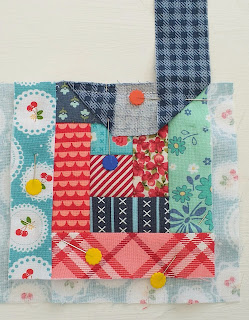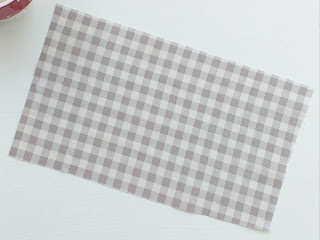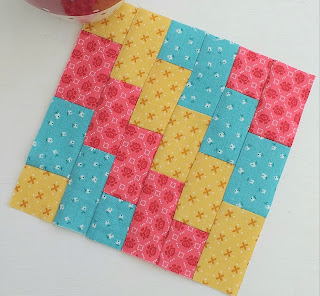I like to use fabric scraps to make something functional and good looking. So I thought I would share with you how to whip up a quilt-as-you-go log cabin coaster for your desk or coffee table.
Instructions are given for a finished coaster measuring 4½” square. To start you will need to cut:One 1½” square for the middle;
Eight 1¼” x 5" strips of fabric for the logs;
One 7" square of batting:
One 7" square of backing fabric;
One 1¼” x 20" strip of fabric for the binding.
NOTE: I prefer to stitch my logs into position and then trim them - it allows me to swap the order around as I go. However, you may prefer to trim your logs before stitching them, in which case you will need to cut one log 1¼” x 1½”; two logs 1¼” x 2¼”; two logs 1¼” x 3", two logs 1¼” x 3¾” and one log 1¼” x 4½” and ignore all reference to trimming logs in the tutorial.
1. Firstly, position the 1½” square in the middle of the batting as shown.
 |
| Position center square in middle of wadding. |
2. Next position the first log so that it aligns with the top left-hand side of the middle square, right sides together.
 |
| Align first log with left-hand side of center square |
3. Stitch the log to the middle square along the 1½” side. Finger press the log open. Note: Do not press with an iron if using synthetic batting - it will ruin your iron.
 |
| Finger press your logs open |
4. Carefully trim the log so that it matches the length of the middle square, but do not cut through the batting (ignore this step if you have pre-cut your logs to size).
 |
| I trim after I have added a log. |
5. Next place the second log, right sides together, along the top of the patched unit aligning the left and top edges as shown.
 |
| Keep adding logs in a clockwise direction |
6. Again stitch along the top edge of the patched unit, stopping just before the end of the center square. Finger press the log open as before. Trim the length of the log so that it matches the length of the patched unit. The patched unit should now measure 2¼” square. (Do not worry if your patchwork doesn't measure exactly this - we will square it up at the end.)
 |
| I often change the order of my strips as I stitch |
7. Repeat the stitching, finger pressing and trimming to add the logs in a clockwise direction until all eight logs have been stitched in place. (If you want a bigger coaster just add a couple of extra logs.)
 |
| Ready for trimming |
8. Once all logs have been stitched in place trim your coaster to 4½" square. I used the lines on my ruler to help with this but if your logs are not straight do not worry - just rename your coaster the Wonky Log Cabin Coaster - it will still look good.
 |
| I use a small rotating cutting mat for small projects |
9. Place the backing square wrong side facing up and place the quilted coaster on top with the right side facing up. Pin or baste together so that they don't move as we bind the coaster.
10. You can bind the coaster using your favourite binding method. I used a 1¼” mitred binding method that I use for my mug rugs and here is how I did it. (I have a PDF on binding methods which may be helpful to print and view at the same time as this tutorial.)
11. At the left-hand side of your binding fold and press the end into a triangle as shown below
 |
| This small step will make the binding neat |
12. Position the folded triangle, right-sides together, approximately half way along the top edge of the coaster aligning the raw edges. Pin in place at the start and place another pin ½" away from the right-hand edge of the coaster.
 |
| I use pins to keep my coaster and backing smooth |
13. Stitch the binding in place using a ¼" seam allowance, stopping when you reach the right-hand pin. Cut the thread and remove the coaster from your sewing machine. Trim the backing fabric along the top edge of the binding to the same size as the coaster.
14. Fold and pin the binding 90 degrees upwards at the right-hand corner of the coaster as shown. The right-hand point of the folded triangle should meet with the right-hand corner of the coaster.
 |
| It looks weird but it works! |
15. Now fold the binding down over the folded corner so that the right-hand edge of the binding aligns with the right-hand edge of the coaster.
 |
| The fold in the binding aligns with the top edge of the coaster |
16. The fold at the top should line up with the top edge of the coaster and the binding strip should lie on top of the coaster right-sides together as shown. |
| You can't see the triangle fold but it is still there. |
17. Place a pin at the very top to keep the fold securely in place. |
| Pinning keeps everything in place |
18. Stitch the binding to the right-hand side of the coaster using a ¼" seam allowance. Cut the threads and remove the coaster from the machine. Trim the backing to match with the right-hand edge of the coaster.
 |
| That is the first mitred corner done. |
The top right-hand corner of the binding should now look like the photo below. |
| Can you see how this is going to work? |
19. Repeat this process to bind the bottom and left-hand edges of the coaster.
20. When you get to the final corner, fold and pin the binding at the corner as you did for the previous three corners.
 |
| The last corner is just the same as the others. |
But this time cut the binding length so that it ends ½" past the raw edge of the folded triangle.
 |
| Cut the end of the binding just passed the triangle fold |
21. Stitch the binding in place from the corner to the end of the binding.
 |
| Phew - all four mitred corners done |
22. Fold the binding away from the middle, towards the back of the coaster.
 |
| Now you can see why the fold at the beginning is a good idea. |
23. At the back of the coaster, turn under ¼" along the raw edge of the binding and slip-stitch in place. I also put a small stitch at each corner to secure the mitred corner.
 |
| Look closely and you can see the triangle fold at the beginning. |
And there you have it - one log cabin coaster. You can download a PDF showing three different binding methods, including the mitred binding method below.
COASTER AND MUG RUG BINDING METHODS
Don't forget to tag me on Instagram if you use this tutorial (@thepatchsmith).
Until next time .....


















































